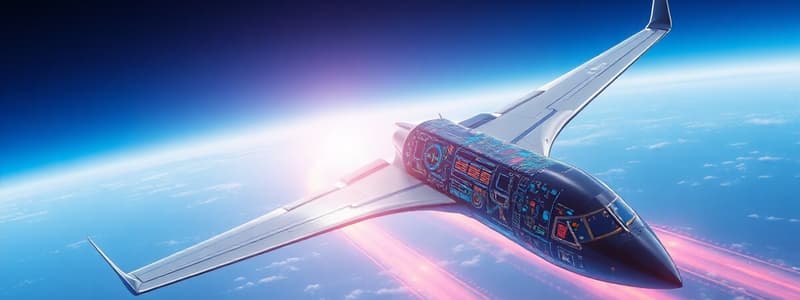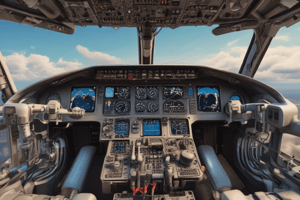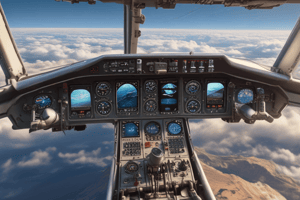Podcast
Questions and Answers
What was the first commercial aircraft to utilize a digital federated architecture?
What was the first commercial aircraft to utilize a digital federated architecture?
- Airbus A320
- Boeing 747
- Boeing 757 (correct)
- Boeing 777
What year did the industry recognize the need for the ability to transfer data files instead of individual data "words" across ARINC 429?
What year did the industry recognize the need for the ability to transfer data files instead of individual data "words" across ARINC 429?
- 1987 (correct)
- 1992
- 1985
- 1990
What was the main reason for the shift from a federated avionics architecture to an Integrated Modular Architecture (IMA)?
What was the main reason for the shift from a federated avionics architecture to an Integrated Modular Architecture (IMA)?
- Reduced weight and cost
- Improved reliability and safety
- Increased flexibility and scalability
- All of the above (correct)
Which of these major functions transitioned from independent LRUs to IMA?
Which of these major functions transitioned from independent LRUs to IMA?
What is the primary limitation of traditional federated avionic systems?
What is the primary limitation of traditional federated avionic systems?
What is the maximum bit rate of traditional ARINC 429 federated architecture?
What is the maximum bit rate of traditional ARINC 429 federated architecture?
What is the primary advantage of ethernet-based data communication in IMA?
What is the primary advantage of ethernet-based data communication in IMA?
What is the primary advantage of a switched ethernet over a classic ethernet in aircraft systems?
What is the primary advantage of a switched ethernet over a classic ethernet in aircraft systems?
Which of the following is a key characteristic of the Avionics Data Communication Network (ADCN)?
Which of the following is a key characteristic of the Avionics Data Communication Network (ADCN)?
What type of network architecture is used in Integrated Modular Avionics (IMA)?
What type of network architecture is used in Integrated Modular Avionics (IMA)?
Which of the following is NOT a benefit of Integrated Modular Avionics (IMA)?
Which of the following is NOT a benefit of Integrated Modular Avionics (IMA)?
What does LRU stand for in the aviation context?
What does LRU stand for in the aviation context?
How do AFDX switches contribute to the robustness of the IMA network?
How do AFDX switches contribute to the robustness of the IMA network?
What is the primary advantage of using a "virtual backplane" in IMA?
What is the primary advantage of using a "virtual backplane" in IMA?
What communication systems are used to distribute passenger address announcements?
What communication systems are used to distribute passenger address announcements?
What is the purpose of the cabin interphone system?
What is the purpose of the cabin interphone system?
Which of the following is an example of a "module" used in IMA?
Which of the following is an example of a "module" used in IMA?
What is the primary function of an AFDX switch?
What is the primary function of an AFDX switch?
Which communication system allows ground maintenance crew to communicate with cockpit and cabin crew?
Which communication system allows ground maintenance crew to communicate with cockpit and cabin crew?
What happens when two PA announcements with different priority levels are initiated simultaneously?
What happens when two PA announcements with different priority levels are initiated simultaneously?
What is the primary function of the cabin monitoring system?
What is the primary function of the cabin monitoring system?
What is the primary purpose of the Cabin Intercommunication Data System (CIDS) or Cabin Service System Controller (CSSC)?
What is the primary purpose of the Cabin Intercommunication Data System (CIDS) or Cabin Service System Controller (CSSC)?
What are the components of the Cabin Core System?
What are the components of the Cabin Core System?
Which of the following is NOT a function of the CIDS/CSSC?
Which of the following is NOT a function of the CIDS/CSSC?
What are the key components of the Airbus Cabin Intercommunication Data System (CIDS)?
What are the key components of the Airbus Cabin Intercommunication Data System (CIDS)?
How are the mini FAPs connected in the CIDS system?
How are the mini FAPs connected in the CIDS system?
What is the purpose of the Flight Attendant Panels (FAPs)?
What is the purpose of the Flight Attendant Panels (FAPs)?
Which system provides the cabin crew with an interface to the Cabin Core System and the Cabin Monitoring System?
Which system provides the cabin crew with an interface to the Cabin Core System and the Cabin Monitoring System?
Which of the following is NOT a subsystem within the Cabin System?
Which of the following is NOT a subsystem within the Cabin System?
What is the primary purpose of the Cabin Monitoring System within the Cabin System?
What is the primary purpose of the Cabin Monitoring System within the Cabin System?
Which of the following is an example of a BITE test that may be performed on the Cabin Core System?
Which of the following is an example of a BITE test that may be performed on the Cabin Core System?
What is the primary method for updating the software of cabin system components?
What is the primary method for updating the software of cabin system components?
Which aspect of the CIDS architecture is responsible for managing and controlling the system?
Which aspect of the CIDS architecture is responsible for managing and controlling the system?
How many predefined cabin layouts are available through the Flight Attendant Panel menu?
How many predefined cabin layouts are available through the Flight Attendant Panel menu?
What type of access code is required to modify cabin layouts?
What type of access code is required to modify cabin layouts?
What is the primary purpose of the loudspeaker level adjustment function?
What is the primary purpose of the loudspeaker level adjustment function?
What is the main function of the Flight Attendant Panel set-up page?
What is the main function of the Flight Attendant Panel set-up page?
What is the basis of the CIDS architecture?
What is the basis of the CIDS architecture?
Which of these functions is NOT performed or controlled by the Flight Attendant Panels (FAPs)?
Which of these functions is NOT performed or controlled by the Flight Attendant Panels (FAPs)?
How many modifiable cabin layouts can be configured through the Flight Attendant Panel menu?
How many modifiable cabin layouts can be configured through the Flight Attendant Panel menu?
What is the main advantage of the modular design of the CIDS system?
What is the main advantage of the modular design of the CIDS system?
Flashcards
Classic Ethernet Shortcoming
Classic Ethernet Shortcoming
Classic Ethernet has long wait times before data transmission due to bus silence.
Switched Ethernet
Switched Ethernet
Switched Ethernet uses routers/switches to direct and buffer data traffic, minimizing delays.
AFDX Switch
AFDX Switch
Avionics Full Duplex Switched Ethernet (AFDX) switch improves data transmission in avionics.
Avionics Data Communication Network (ADCN)
Avionics Data Communication Network (ADCN)
Signup and view all the flashcards
Integrated Modular Avionics (IMA)
Integrated Modular Avionics (IMA)
Signup and view all the flashcards
Weight Savings in IMA
Weight Savings in IMA
Signup and view all the flashcards
Aircraft Data Network (ADN)
Aircraft Data Network (ADN)
Signup and view all the flashcards
Line Replaceable Modules (LRMs)
Line Replaceable Modules (LRMs)
Signup and view all the flashcards
Virtual Backplane
Virtual Backplane
Signup and view all the flashcards
Cabin Monitoring System
Cabin Monitoring System
Signup and view all the flashcards
Passenger Address (PA)
Passenger Address (PA)
Signup and view all the flashcards
Cabin Interphone
Cabin Interphone
Signup and view all the flashcards
Service Interphone
Service Interphone
Signup and view all the flashcards
Communication Functions
Communication Functions
Signup and view all the flashcards
BITE Testing
BITE Testing
Signup and view all the flashcards
Cabin System
Cabin System
Signup and view all the flashcards
Cabin Core System
Cabin Core System
Signup and view all the flashcards
Cabin Intercommunication Data System (CIDS)
Cabin Intercommunication Data System (CIDS)
Signup and view all the flashcards
Cabin Service System Controller (CSSC)
Cabin Service System Controller (CSSC)
Signup and view all the flashcards
CIDS Directors
CIDS Directors
Signup and view all the flashcards
Flight Attendant Panels (FAPs)
Flight Attendant Panels (FAPs)
Signup and view all the flashcards
Mini FAPs
Mini FAPs
Signup and view all the flashcards
In-Flight Entertainment System (IFE)
In-Flight Entertainment System (IFE)
Signup and view all the flashcards
BITE testing capabilities
BITE testing capabilities
Signup and view all the flashcards
Federated architecture
Federated architecture
Signup and view all the flashcards
ARINC 429
ARINC 429
Signup and view all the flashcards
Ethernet-based communication
Ethernet-based communication
Signup and view all the flashcards
AIMS Cabinet
AIMS Cabinet
Signup and view all the flashcards
Bit rate
Bit rate
Signup and view all the flashcards
CIDS
CIDS
Signup and view all the flashcards
Software Loading
Software Loading
Signup and view all the flashcards
Layout Selection
Layout Selection
Signup and view all the flashcards
Cabin Programming
Cabin Programming
Signup and view all the flashcards
Loudspeakers Level Adjustment
Loudspeakers Level Adjustment
Signup and view all the flashcards
CIDS Architecture
CIDS Architecture
Signup and view all the flashcards
Access Code Protection
Access Code Protection
Signup and view all the flashcards
Internal Settings Control
Internal Settings Control
Signup and view all the flashcards
Study Notes
Typical Electronic/Digital Aircraft Systems II (5.15)
- Learning objectives include describing the general arrangement and BITE testing capabilities of Integrated Modular Avionics (IMA), Cabin Systems, and Information Systems at Level 2.
Integrated Modular Avionics (IMA) Background
- Boeing 767 and 757 were the first commercial aircraft to use a digital federated architecture.
- In 1987, the industry recognised the need to transfer data files as opposed to individual data words.
- Beginning with the Boeing 777, integrated modular architectures were adopted with the Airplane Information Management System (AIMS) cabinet.
- This approach integrated previously separate components like flight management, communications management, and aircraft condition monitoring into a unified system.
IMA Advantages
- Traditional avionics systems are based on federated systems.
- Subsystems exist on separate hardware; expansion is complex.
- Additional LRUs necessitate additional connections increasing hardware complexity.
- Bit rates are limited to approximately 100Kbps in one direction.
Classic ARINC 629 Ethernet - Improved Bit Rate
- The classic Ethernet approach requires a direct connection of each unit to the common bus.
- Bit rates are improved to 10 Mbps.
- A shortcoming of the classic Ethernet is that large systems have long wait times for the bus to fall silent.
AFDX Switched Ethernet
- Integrated Modular Avionics (IMA) uses a common platform, sharing resources like memory and processors, and enhancing usage of resources.
- Reduced weight, size, power, and cost are some advantages over prior systems.
Cabin Systems Overview
- The cabin system provides an interface for cabin crew to the cabin core and cabin monitoring system.
- Passengers use the entertainment system.
- Three subsystems comprise the cabin system: cabin core, monitoring, and in-flight entertainment (IFE).
Cabin Core System
- Manufacturers have differing systems, Airbus uses a Cabin Intercommunication Data System (CIDS), and Boeing uses a Cabin Service System Controller (CSSC).
- CIDS/CSSC manages, controls, monitors, and transmits data between cabin systems, passengers, and crew.
- It enables testing different systems and units.
- The Airbus CIDS system uses two central CIDS directors, touch-screen Flight Attendant Panels (FAPs), and mini-FAPs.
- FAPs and mini-FAPs connect to CIDS directors, which connect to systems related to passengers and crew.
Basic CIDS Operations
- Software loading updates cabin system components' software through the Flight Attendant Panel (FAP).
- Three pre-defined and three customisable cabin layouts are accessible through the FAP.
- Layout selection is protected by an access code, only accessible on the ground.
- Cabin programming allows modifying zone configurations (via FAP).
- Loudspeaker level adjustment allows for manual adjustment of cabin loudspeaker settings via the MP FAP menu page, which is protected by an access code.
CIDS Architecture
- CIDS is modular, meaning component count adapts to cabin layout needs.
- Director (controllers) support bus lines and network concepts.
Multi-Purpose Flight Attendant Panels (MP FAP)
- Touchscreen interfaces between cabin attendants and CIDS directors; the Boeing equivalent is the Crew Attendant Panel (CAP).
Additional Indication Panels (AIPs)
- Displays dial and call information from Passenger Address (PA) or the interphone.
- Additional cabin information, e.g., lavatory smoke location, is also displayed on the indicator panel.
Additional Attendant Panels (AAPs)
- Allows attendants to control specific cabin support systems and passenger-related functions in a defined cabin zone.
Cabin Monitoring System: Communication Functions
-
Passenger Address (PA) distributes announcements to all assigned cabin speakers and passenger headsets.
-
Higher priority sources interrupt lower priority announcements. Only the higher-priority message is heard.
-
Cabin interphone connects cabin crew stations and cockpit to the cabin crew stations.
-
Service interphone connects ground maintenance crews, cockpit, and cabin crew.
In-Flight Entertainment (IFE) System
- Provides passengers with audio, video, data, and interactive functions (games, etc.) through a cabin distribution network.
Information Systems (Aircraft Information Systems)
- Aims to improve flight, cabin, and maintenance operations.
- Networked "real-time" servers and secure digital communications are involved.
- Data is gathered, centralised, and used to support multiple operations (flight, ground, etc.).
- Enhancements include replacing paper documents with electronic forms and providing more intuitive data access for maintenance and cabin crew. Passengers can also access electronic mail and internet services.
Health Management Systems (Boeing AHM and Airbus AIRMAN)
- Boeing Aeroplane Health Management (AHM) monitors systems and parts, and allows users to troubleshoot concerns during flight. Real-time data is sent to ground operations.
- Airbus AIRMAN is a maintenance application, optimizing maintenance by monitoring the health of the aircraft. Providing quick issue identification and resolution.
Cabin Systems BITE Testing
- Refer to BITE Philosophy and BITE Function headings for more detailed information on cabin BITE testing methodology. BITE management is available in these systems via the Flight Attendant Panel (FAP) display and the flight deck Multi-Function Display (MCDU).
Studying That Suits You
Use AI to generate personalized quizzes and flashcards to suit your learning preferences.




